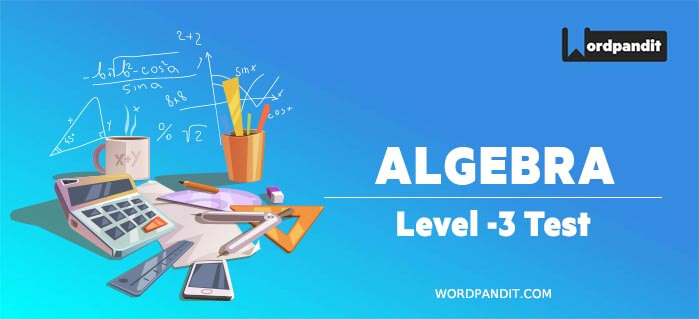- This is an assessment test.
- To draw maximum benefit, study the concepts for the topic concerned.
- Kindly take the tests in this series with a pre-defined schedule.
Algebra Level 3 Test 2
Congratulations - you have completed Algebra Level 3 Test 2.You scored %%SCORE%% out of %%TOTAL%%.You correct answer percentage: %%PERCENTAGE%% .Your performance has been rated as %%RATING%%
Your answers are highlighted below.
Question 1 |
Let S denotes the infinite sum 2 + 5x + 9x2 + 14x3 + 20x4 + …..where IxI < 1 and the coefficient of xn–1 is ½ n(n+3),(n = 1,2,………). Then what will be the value of S
(2 – x)/(1-x)3 | |
(2 – x)/(1+x)3 | |
(2 + x)/(1-x)3 | |
(2 + x)/(1+x)3 |
Question 1 Explanation:
Coefficient of xn = 1/2(n - 1)(n + 4)
S= 2 + 5x + 9x2 + 14x3 + 20x4 +….. (i)
Multiply by x
xS = 2x + 5x2 + 9x3 + ……….. (ii)
Subtract second equation from first
S(1– x) = 2 + 5x + 9x2 + 14x3 + 20x4
Let p = S(1– x)
P = 2 + 3x + 4x2 + ……………………
Again multiply with x
Px = 2x +3x2 + …………….
On subtracting second from first
p(1 –x) = 2 + x + x2
Now it is in G.P.
So the sum is 2 + x / (1+x)
S = (2-x)/ (1 – x)3
S= 2 + 5x + 9x2 + 14x3 + 20x4 +….. (i)
Multiply by x
xS = 2x + 5x2 + 9x3 + ……….. (ii)
Subtract second equation from first
S(1– x) = 2 + 5x + 9x2 + 14x3 + 20x4
Let p = S(1– x)
P = 2 + 3x + 4x2 + ……………………
Again multiply with x
Px = 2x +3x2 + …………….
On subtracting second from first
p(1 –x) = 2 + x + x2
Now it is in G.P.
So the sum is 2 + x / (1+x)
S = (2-x)/ (1 – x)3
Question 2 |
If x2 + 5y2 + z2 = 2y(2x + z) , then which of the following statements is(are) necessarily true?
A. x = 2y
B. x = 2z
C. 2x = z
Only A | |
B and C | |
A and B | |
None of these |
Question 2 Explanation:
x2 + 5y2 + z2 = 4yx + 2yz
(x2 + 4y2 – 4yx) + z2 + y2 – 2yz = 0
(x – 2y)2 + (z – y)2 = 0
It can be true only if x = 2y and z = y
(x2 + 4y2 – 4yx) + z2 + y2 – 2yz = 0
(x – 2y)2 + (z – y)2 = 0
It can be true only if x = 2y and z = y
Question 3 |
Amol was asked to calculate the arithmetic mean of 10 positive integers, each of which had 2 digits. By mistake, he interchanged the 2 digits, say a and b, in one of these 10 integers. As a result, his answer for the arithmetic mean was 1.8 more than what it should have been. Then b – a equals
1 | |
2 | |
3 | |
None of these |
Question 3 Explanation:
Arithmetic mean is more by 1.8 times than what it should
have been, this means sum is more by 18.
So ba – ab = 18,
This means b > a as sum has gone up, e.g. 31 – 13 = 18
Hence, b – a = 2
have been, this means sum is more by 18.
So ba – ab = 18,
This means b > a as sum has gone up, e.g. 31 – 13 = 18
Hence, b – a = 2
Question 4 |
A child was asked to add first few natural numbers (i.e. 1 + 2 + 3 + …) so long his patience permitted. As he stopped, he gave the sum as 575. When the teacher declared the result wrong, the child discovered he had missed one number in the sequence during addition. The number he missed was
less than 10 | |
10 | |
15 | |
more than 15 |
Question 4 Explanation:
Sum of natural numbers = n(n+1)/2 = (n2 +n) /2
So according to the question
(n2 +n) /2 – x = 575
On solving it is clear that
1150 = n2 + n – 2x
n(n + 1)greater than equal to 1150
(n2 +n) greater than equal to 1150
Therefore for this the smallest value of x is 20
So according to the question
(n2 +n) /2 – x = 575
On solving it is clear that
1150 = n2 + n – 2x
n(n + 1)greater than equal to 1150
(n2 +n) greater than equal to 1150
Therefore for this the smallest value of x is 20
Question 5 |
The number of real roots of the equation p2 / (x) + q2/ (x -1) = 1 where p and q are real numbers not equal to zero simultaneously, is
None | |
1 | |
2 | |
1 or 2 |
Question 5 Explanation:
p2 / (x) + q2/ (x -1) = 1
p2 (x -1) + q2(x) = x2 – x
This is a quadratic equation.
Hence, number of roots = 2 or 1 (1 in the case when both roots are equal).
p2 (x -1) + q2(x) = x2 – x
This is a quadratic equation.
Hence, number of roots = 2 or 1 (1 in the case when both roots are equal).
Once you are finished, click the button below. Any items you have not completed will be marked incorrect.
There are 5 questions to complete.
List |











